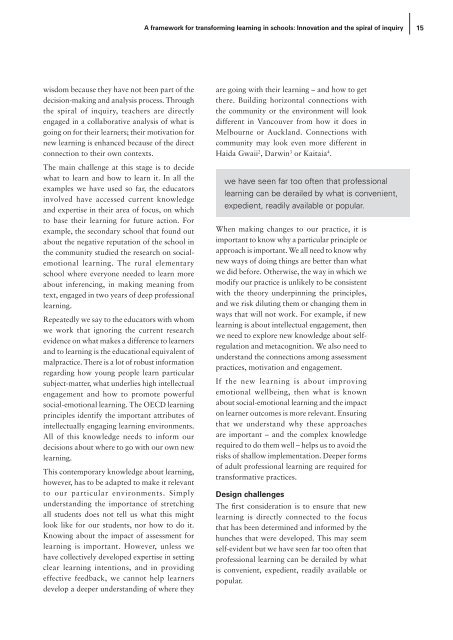Spiral of Inquiry
Spiral of Inquiry
Spiral of Inquiry
- No tags were found...
Create successful ePaper yourself
Turn your PDF publications into a flip-book with our unique Google optimized e-Paper software.
A framework for transforming learning in schools: Innovation and the spiral <strong>of</strong> inquiry 15wisdom because they have not been part <strong>of</strong> thedecision-making and analysis process. Throughthe spiral <strong>of</strong> inquiry, teachers are directlyengaged in a collaborative analysis <strong>of</strong> what isgoing on for their learners; their motivation fornew learning is enhanced because <strong>of</strong> the directconnection to their own contexts.The main challenge at this stage is to decidewhat to learn and how to learn it. In all theexamples we have used so far, the educatorsinvolved have accessed current knowledgeand expertise in their area <strong>of</strong> focus, on whichto base their learning for future action. Forexample, the secondary school that found outabout the negative reputation <strong>of</strong> the school inthe community studied the research on socialemotionallearning. The rural elementaryschool where everyone needed to learn moreabout inferencing, in making meaning fromtext, engaged in two years <strong>of</strong> deep pr<strong>of</strong>essionallearning.Repeatedly we say to the educators with whomwe work that ignoring the current researchevidence on what makes a difference to learnersand to learning is the educational equivalent <strong>of</strong>malpractice. There is a lot <strong>of</strong> robust informationregarding how young people learn particularsubject-matter, what underlies high intellectualengagement and how to promote powerfulsocial-emotional learning. The OECD learningprinciples identify the important attributes <strong>of</strong>intellectually engaging learning environments.All <strong>of</strong> this knowledge needs to inform ourdecisions about where to go with our own newlearning.This contemporary knowledge about learning,however, has to be adapted to make it relevantto our particular environments. Simplyunderstanding the importance <strong>of</strong> stretchingall students does not tell us what this mightlook like for our students, nor how to do it.Knowing about the impact <strong>of</strong> assessment forlearning is important. However, unless wehave collectively developed expertise in settingclear learning intentions, and in providingeffective feedback, we cannot help learnersdevelop a deeper understanding <strong>of</strong> where theyare going with their learning – and how to getthere. Building horizontal connections withthe community or the environment will lookdifferent in Vancouver from how it does inMelbourne or Auckland. Connections withcommunity may look even more different inHaida Gwaii 2 , Darwin 3 or Kaitaia 4 .we have seen far too <strong>of</strong>ten that pr<strong>of</strong>essionallearning can be derailed by what is convenient,expedient, readily available or popular.When making changes to our practice, it isimportant to know why a particular principle orapproach is important. We all need to know whynew ways <strong>of</strong> doing things are better than whatwe did before. Otherwise, the way in which wemodify our practice is unlikely to be consistentwith the theory underpinning the principles,and we risk diluting them or changing them inways that will not work. For example, if newlearning is about intellectual engagement, thenwe need to explore new knowledge about selfregulationand metacognition. We also need tounderstand the connections among assessmentpractices, motivation and engagement.If the new learning is about improvingemotional wellbeing, then what is knownabout social-emotional learning and the impacton learner outcomes is more relevant. Ensuringthat we understand why these approachesare important – and the complex knowledgerequired to do them well – helps us to avoid therisks <strong>of</strong> shallow implementation. Deeper forms<strong>of</strong> adult pr<strong>of</strong>essional learning are required fortransformative practices.Design challengesThe first consideration is to ensure that newlearning is directly connected to the focusthat has been determined and informed by thehunches that were developed. This may seemself-evident but we have seen far too <strong>of</strong>ten thatpr<strong>of</strong>essional learning can be derailed by whatis convenient, expedient, readily available orpopular.


